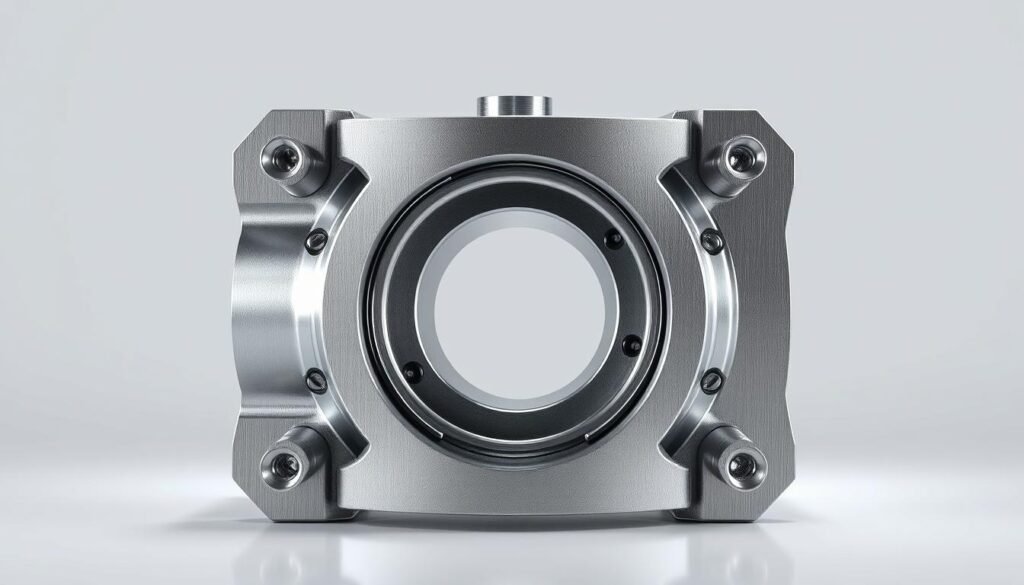Aluminium density is key in engineering and material science. Knowing aluminium’s density in lb/in3 is vital for those designing lightweight structures. This guide shows aluminium’s density is about 0.1 lb/in3, or 2,700 kg/m3.
Its low density makes aluminium better than heavier metals like steel. This is why it’s used where weight matters and performance is key.
Introduction to Aluminium Density
The introduction to aluminium density gives us key insights into this metal’s role in many fields. Aluminium is known for being light yet strong. This makes it perfect for uses where you need something tough but not too heavy.
Learning about the basic aluminium characteristics shows us its density is about 2.7 g/cm³, or 0.1 lb/in³. This low density is what makes aluminium stand out from other metals. Knowing about aluminium density helps experts choose the right materials for their projects.
The Importance of Aluminium Density in Engineering
Understanding the aluminium density importance is key in engineering. Aluminium’s low density makes it great for creating light structures. This is vital in aerospace, automotive, and construction.
These sectors need strong yet light designs. This boosts efficiency and performance. Aluminium fits the bill perfectly.
The strength-to-weight ratio of aluminium is a big plus. It’s perfect for high-strength, low-weight needs. For example, in aircraft, it helps save fuel.
Choosing the right aluminium is all about density. It helps engineers pick the best materials for their projects.

Using aluminium also saves costs in production and upkeep. Engineers choose materials based on density to meet performance and budget needs. By looking at different aluminium alloys’ densities, they create designs that fit the project’s needs.
Learn more about material selectionbased on density.
What is the Density of Aluminium in lb/in3?
The density of aluminium is key in many industries, like engineering and manufacturing. It has a density of about 0.1 lb/in³. This makes aluminium lighter than many metals, which is great for materials needing strength without being too heavy.
Standard Density Values
Aluminium alloys have different densities, affecting their performance. Here’s a table showing the density of common aluminium alloys:
| Aluminium Alloy | Density (lb/in³) |
|---|---|
| Aluminum Alloy 1100 | 0.098 |
| Aluminum Alloy 2014 | 0.101 |
| Aluminum Alloy 2024 | 0.100 |
| Aluminum Alloy 3003 | 0.099 |
| Aluminum Alloy 7075 | 0.101 |
| Aluminum Alloy 5052 | 0.097 |
| Aluminum Alloy 6061 | 0.098 |
| Aluminum Alloy 6063 | 0.097 |
Comparison with Other Metals
Aluminium is much lighter than other metals when you compare them. Steel weighs about 0.283 lb/in³, and copper is 0.321 lb/in³. This makes aluminium perfect for places where you need something light but strong. Knowing how aluminium compares to other metals helps engineers pick the best material for their projects.
To learn more about aluminium standard density values for different alloys, check out detailed sources. They offer lots of data and comparisons.
Factors Affecting Aluminium Density
Understanding the aluminium density factors is key for many uses. Temperature and alloy composition are major influences. These factors can change density a lot, affecting how well the material works in different places and uses.
Temperature Effects
Temperature is very important for aluminium density. When it gets hotter, aluminium expands and its density goes down. On the other hand, cooling it makes it contract and density goes up. This temperature impact is big in extreme heat or cold, changing how it works and what it can do.
Alloy Composition and Impurities
Aluminium grades have different elements to improve their properties. The alloy composition changes density in different aluminium types. Adding magnesium or silicon, for example, changes density and strength. Impurities like iron also affect density, slightly changing how the material behaves. Knowing these changes helps engineers pick the right alloys for their projects.

| Factor | Impact on Density |
|---|---|
| Temperature Increase | Decreases density due to expansion |
| Temperature Decrease | Increases density due to contraction |
| Alloy Composition | Varies density with different elements |
| Impurities | Can subtly alter density properties |
Types of Aluminium Alloys and their Densities
The world of aluminium alloys is vast, with many types suited for different uses. These alloys are mainly divided into wrought and casting types. Each type has unique properties that affect their density, which is key when choosing materials.
Wrought alloys are very versatile. They include series like 2xxx and 7xxx, known for being strong and light. Series like 1xxx and 3xxx are great for resisting corrosion and are easy to work with. The density of wrought aluminium usually ranges from 2.5 to 3.0 g/cm³, depending on the alloy.
Casting alloys, like those in series 2xx.x and 3xx.x, have different properties. They often have a lower density than wrought alloys. This is because of the different elements in their composition, which affect their strength and heat resistance.
The table below shows different aluminium alloys and their densities. It helps us see how density affects engineering materials:
| Aluminium Alloy Type | Density (g/cm³) |
|---|---|
| Wrought – 1xxx Series | 2.70 |
| Wrought – 2xxx Series | 2.80 |
| Wrought – 3xxx Series | 2.73 |
| Wrought – 7xxx Series | 2.83 |
| Casting – 2xx.x Series | 2.60 |
| Casting – 3xx.x Series | 2.68 |
Knowing how aluminium alloy types and densities relate is key in picking materials for engineering. Remember, density changes can greatly impact how well a material works in a project.
Common Aluminium Alloys and Their Densities
Aluminium alloys are key in many industries because of their density and uses. Knowing these alloys and their densities helps engineers pick the right materials. This ensures they meet specific needs.
Room Temperature Density Values
Here are some common aluminium alloys and their density values at room temperature:
| Alloy | Density (kg/m³) | Density (lb/in³) |
|---|---|---|
| Aluminium Alloy 1100 | 2720 | 0.098 |
| Aluminium Alloy 2014, Annealed | 2800 | 0.101 |
| Aluminium Alloy 3003, Rolled | 2730 | 0.099 |
| Aluminium Alloy 6061 | 2720 | 0.098 |
| Duralumin | 2790 | 0.101 |
| Aluminium Alloy 7075 | 2800 | 0.101 |
Applications of Different Alloys
Each aluminium alloy has its own use in different fields:
- Alloy 3003 is great for cookware because it’s easy to shape and has good strength.
- Alloy 6061 is used in buildings and boats because it doesn’t rust easily.
- Alloy 7075 is used in planes because it’s strong but light.
- Alloy 2024 is used in planes because it lasts a long time under stress.
To learn more about aluminium alloy densities, check out density values for aluminium alloys. This info helps engineers choose the best material for their projects.

Methods to Calculate Aluminium Density
Getting the right density of aluminium is key for many engineering and manufacturing tasks. There are several ways to measure aluminium density, each with its own use.
The basic method is the density formula: density equals mass divided by volume. You need to know the mass and volume of the aluminium to do this.
Archimedes’ principle is a great technique. It involves putting the aluminium in a liquid and measuring how much liquid it pushes out. This tells you the volume of the aluminium. Then, you can find the density by dividing the mass by this volume.
Another method uses a pycnometer, a tool for precise density measurements. It’s perfect for labs and small samples because it’s so accurate.
| Technique | Description | Advantages |
|---|---|---|
| Mass Measurement | Using a scale to find the mass of the aluminium sample. | Simple and direct measurement. |
| Volume Displacement | Calculating volume based on fluid displacement using Archimedes’ principle. | Effective for irregularly shaped objects. |
| Hydrostatic Weighing | Measuring mass in air and then submerged in a fluid. | Gives precise volume measurement with respect to buoyancy. |
| Pycnometer | A specialized device for determining density in a controlled environment. | High accuracy and reliability. |
Learning about these methods can help you better understand and calculate aluminium density. This ensures you make accurate choices when selecting materials.
Applications of Aluminium Based on Density
The density of aluminum greatly affects its use in many fields. In cars, aluminum’s low density means better fuel efficiency. This is because lighter cars use less energy.
Car makers can create strong yet light structures. This is thanks to aluminum’s unique properties.
In the aerospace world, every gram matters. Aluminum’s lightness and strength are key. It helps planes fly better and carry more without using more fuel.
Construction also benefits from aluminum’s lightness and strength. It makes building faster and cheaper. Using aluminum shows how important its density is in choosing materials and designing.
How to Use Density in Material Selection
In engineering and design, picking the right materials is key. Knowing about density in engineering is very important. Density affects how strong a material is compared to its weight, which is critical for aluminium.
When choosing materials, think about these points:
- Weight Requirements: Lighter materials can make things more fuel-efficient, like in cars.
- Strength Considerations: A material’s density often shows its strength. This affects how long it lasts and how safe it is.
- Application Needs: Certain fields, like aerospace and cars, need materials that are both light and strong. Knowing about aluminium density helps meet these needs.
To pick the best materials, engineers should look at aluminium’s properties and compare them to others. This way, they can find materials that work well for their needs and don’t weigh too much.
Importance of Accurate Density Measurements
Knowing the importance of accurate density measurements is key in industries that use aluminium. When aluminium’s density is measured right, it shows the material’s properties and if it fits certain uses. In quality checks, getting the density right means materials meet the needed standards.
There are many reasons why density might not match up, like changes in the alloy, impurities, or how it’s made. These issues can cause failures, leading to aluminium quality problems and safety risks. So, it’s important to measure with precision to keep projects reliable and safe.
Getting the density right is essential for things like building structures and managing heat. Using precise tools helps make products better in design and making. For more info on density, check out measurement significance to help engineers make better choices.
| Density Measurement Factors | Impact on Quality |
|---|---|
| Temperature Variations | Can affect density readings, altering the material’s properties. |
| Alloy Composition | Changes in the alloy can lead to significant differences in density. |
| Impurities | Presence of foreign materials can distort true density measurements. |
| Mechanical Processing | May influence grain size, impacting the final density. |
Conclusion
This article has looked into how density affects aluminium’s properties and uses. Aluminium is light but strong, making it popular in engineering and manufacturing. Knowing its density helps engineers pick the right materials for better performance and cost.
Alloy composition and environmental factors change aluminium’s density. Accurate density measurements are key for predicting its performance. This knowledge guides design choices, making aluminium a key part of modern engineering.
Aluminium’s mix of density, strength, and versatility makes it a top choice for many uses. By understanding these aspects, professionals can use aluminium to innovate and improve efficiency in their work.
